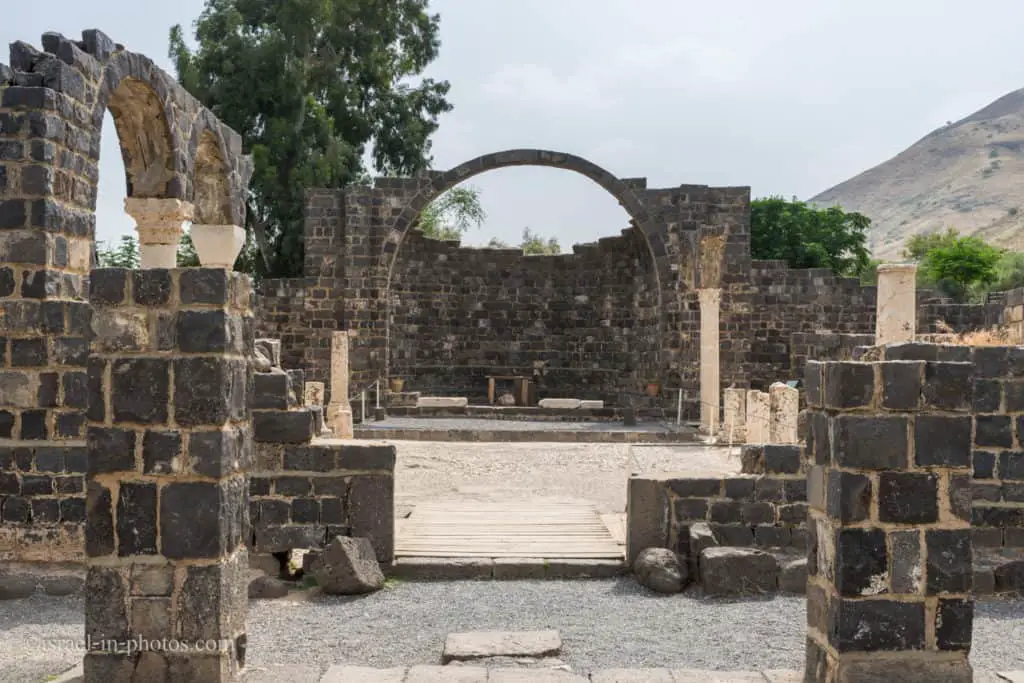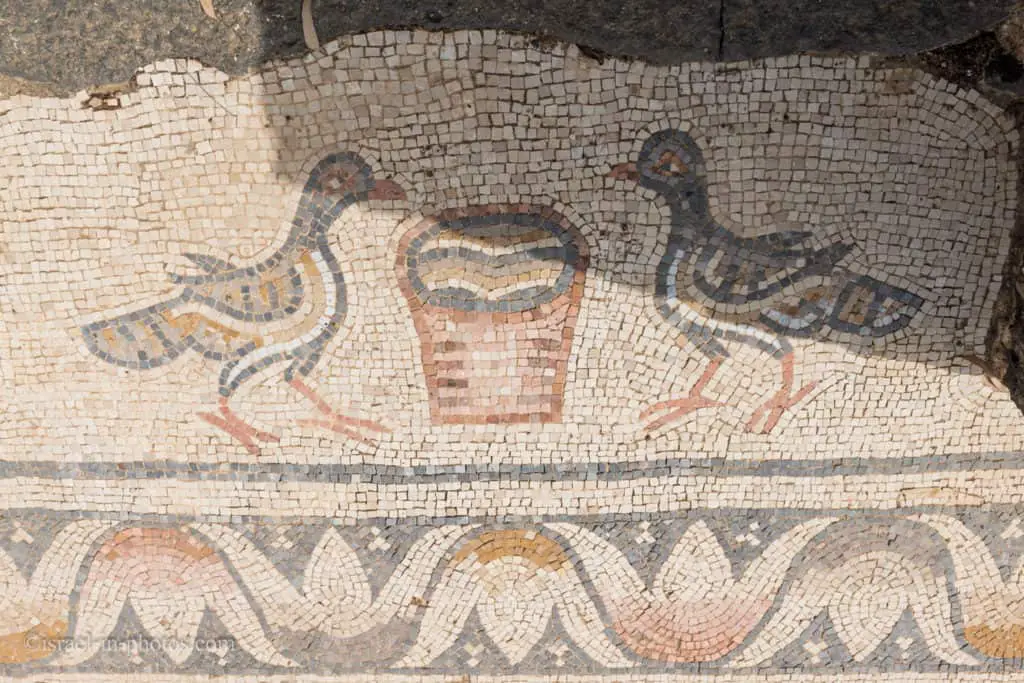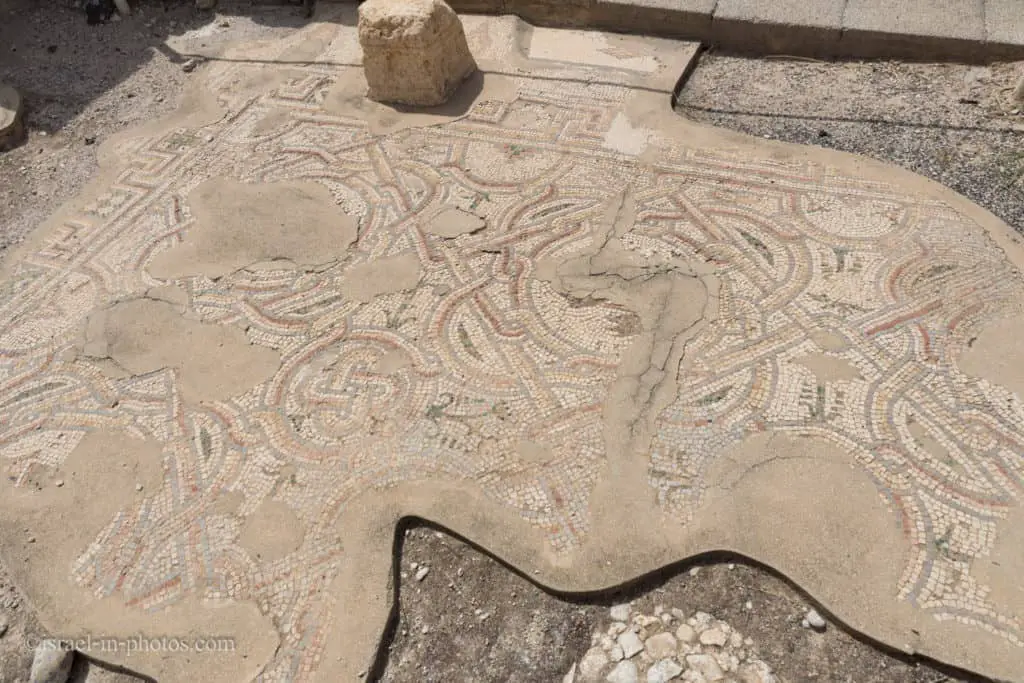Kursi National Park – Miracle of the Swine – Visitors Guide
Kursi National Park contains remains of a Byzantine monastery and is traditionally recognized as the site of Jesus` Miracle of the Swine.
On a personal note, I wanted to say that when I created Israel National Parks And Nature Reserves, it became evident which places I missed or have not visited in recent years. And indeed, Kursi is a less popular national park, but it does not mean it is less important. So today, we are going to fix that gap.
Table of Contents
Map
Kursi National Park is located on Golan Heights, on the eastern shore of the Sea of Galilee.
Directions for drivers: Link to Waze and Link to Google Maps
Directions for public transport: Link to Moovit
Interactive map of the area:
And on the following Sea Of Galilee map, you can see this national park on the right shore. You can also see other important places.

Directions
If you are reaching by car, enter “Kursi National Park” into Waze or Google Maps, and it will take you there. Furthermore, you will find a free parking lot near the entrance.
And if you are using public transport, you can take a bus to Kursi junction (for example, line #51). Here is the updated link to Moovit. Enter your starting point, and you will get the updated directions.
Opening Hours
Sunday – Thursday and Saturday: 8:00 – 17:00 (16:00 in winter).
Friday: 8:00 – 16:00 (15:00 in winter).
On holiday eves, usually 8:00 – 13:00.
Note: Since the pandemic, the Israel Nature and Parks Authority has started limiting the number of people in each park. Thus, reservations are recommended through the official site (you can find the link below).
Entrance to the site closes one hour before the time mentioned above.
Entrance Fee
Adults 14 NIS, children 7 NIS, and Students 12 NIS. And free for National Parks annual (Matmon) subscribers.
If you are going to visit several National Parks, then consider purchasing a combo ticket. You can find additional info in National Parks And Nature Reserves.
Note: opening hours and ticket prices were updated in December 2022. In any case, recheck the official site before visiting.

Gergesa
According to Christian tradition, Kursi is Gergesa, which identifies as the site where Jesus performed the miracle of the swine. But what is Gergesa?
Gergesa, also Gergasa or the Country of the Gergesenes, is a place on the eastern (Golan Heights) side of the Sea of Galilee located at some distance to the ancient Decapolis cities of Gadara and Gerasa. Today, it is the modern El-Koursi. It is mentioned in some ancient manuscripts of the Gospel of Matthew as the place where the Miracle of the Swine took place, an exorcism performed by Jesus who drove demons out of two possessed men and into a herd of pigs. All three Synoptic Gospels mention this miracle, but only Matthew writes about two possessed men instead of just one, and only some manuscripts of his Gospel name the location as Gergesa, while the other copies, as well as all versions of Luke and Mark, mention either Gadara or Gerasa (see Mark 5:1-20, Luke 8:26-39, Matthew 8:28-34).
Some believe that Gergesa was the country of the ancient Girgashites, but it is more probable that ‘Gergesenes’ was introduced by Origen upon mere conjecture. Before him, most copies seem to have read ‘Gadarenes,’ agreeable to the parallel passages and the ancient Syriac version. In any event, the “country of the Gergesenes/Gadarenes/Gerasenes” in the New Testament Gospels refers to some location on the eastern shore of the Sea of Galilee. The name is derived from either a lakeside village, Gergesa, the next larger city, Gadara, or the best-known city in the region, Gerasa.
Source: Wikipedia
Side note: The Gospel Of Mark mentions a herd of swine, suggesting they were livestock. But pigs are not Kosher. Thus Jews would not raise swine. So this might indicate that Gergesa was not a Jewish village.
Miracle of the Swine
The exorcism of the Gerasene demoniac, frequently known as the Miracle of the (Gadarene) Swine, is one of the miracles performed by Jesus according to the New Testament. The story shows Jesus exorcising a demon or demons out of a man and into a herd of swine, causing the swine to run down a hill into a lake and drown themselves.
The story appears in the three Synoptic Gospels, but not the Gospel of John. All accounts involve Jesus exorcising demons, identified collectively in Mark and Luke as “Legion.”
Source: Wikipedia
Jesus Heals The Gerasene Demoniac – The Gospel of Mark
Let’s look at the earliest account from the Gospel of Mark (Mark 5:1-20 New Revised Standard Version):
5 They came to the other side of the sea, to the country of the Gerasenes. 2 And when he had stepped out of the boat, immediately a man out of the tombs with an unclean spirit met him. 3 He lived among the tombs; and no one could restrain him any more, even with a chain; 4 for he had often been restrained with shackles and chains, but the chains he wrenched apart, and the shackles he broke in pieces; and no one had the strength to subdue him. 5 Night and day among the tombs and on the mountains he was always howling and bruising himself with stones. 6 When he saw Jesus from a distance, he ran and bowed down before him; 7 and he shouted at the top of his voice, “What have you to do with me, Jesus, Son of the Most High God? I adjure you by God, do not torment me.” 8 For he had said to him, “Come out of the man, you unclean spirit!” 9 Then Jesus asked him, “What is your name?” He replied, “My name is Legion; for we are many.” 10 He begged him earnestly not to send them out of the country. 11 Now there on the hillside a great herd of swine was feeding; 12 and the unclean spirits begged him, “Send us into the swine; let us enter them.” 13 So he gave them permission. And the unclean spirits came out and entered the swine; and the herd, numbering about two thousand, rushed down the steep bank into the sea, and were drowned in the sea.
14 The swineherds ran off and told it in the city and in the country. Then people came to see what it was that had happened. 15 They came to Jesus and saw the demoniac sitting there, clothed and in his right mind, the very man who had had the legion; and they were afraid. 16 Those who had seen what had happened to the demoniac and to the swine reported it. 17 Then they began to beg Jesus to leave their neighborhood. 18 As he was getting into the boat, the man who had been possessed by demons begged him that he might be with him. 19 But Jesus refused, and said to him, “Go home to your friends, and tell them how much the Lord has done for you, and what mercy he has shown you.” 20 And he went away and began to proclaim in the Decapolis how much Jesus had done for him; and everyone was amazed.
What Does Kursi Mean?
The official site does not mention anything about the name besides that Kursi is an Arabic name. I did some digging, and Kursi is the Arabic word for the throne.
The Arabic word for the throne. It has been borrowed into Persian, Bengali, Turkish, Punjabi, Hindi, and Urdu with similar meaning related to “chair,” and may also be used for an official title, such as that of a president or chairman.
Source: Wikipedia
The Hebrew word for a chair is very similar, and the origin of the name may be due to the area’s geographical features.
Kursi lies near the southern banks of Samakh river, one of the longest rivers in the Golan Heights. The river carries considerable silt, which creates a tongue of land that projects hundreds of meters into the Sea of Galilee. This tongue was known in the past as “Kursi Head.” In the area of the river estuary is a narrow and fertile basin, 3 km in length.
Note: unless stated otherwise, all quotes were taken from the official site.
But remember that this is only a version, as I have not seen any mentions of this topic on the official site.
The Discovery Of Kursi
The Kursi ruins were discovered by chance by Mendel Nun after the Six Day War when the road to the foothills of the Golan Heights was being paved. The road was supposed to pass right over the remains of the Byzantine church, and it is only thanks to Mendel Nun that its path was diverted at the very last moment, and the site was saved.
Excavations carried out here by Vassilios Tzaferis, and Dan Orman revealed the ruins of a monastery from the Byzantine period, one of the largest monasteries in Israel. The monastery and the church within it were built in the mid-fifth century CE.
The church was destroyed during the Persian invasion (614), renovated, but destroyed again in the earthquake of the eighth century, and not restored.
The Byzantine Monastery and Church

The monastery and church – the ruins that can be seen today were built in the Byzantine period. The monastery was surrounded by a stone wall (145 x 123 m) and is one of the largest in Israel. It appears that not only monks lived in the compound, but also members of a Christian sect that set itself apart from the nearby Jewish settlement on the shores of the Sea of Galilee. In the courtyard of the monastery, there were public buildings, houses, farm buildings, agricultural and fishing facilities, and a hostel serving pilgrims.
The Church
We will start by visiting the church.

A dirt road led up from the lake to the monumental gate of the compound, with a watchtower alongside it. From the gate, a paved road led to a large church (45 x 23 m) – a basilica, with two rows of six columns dividing the central space of the church into the nave and two aisles. The stone columns and marble Corinthian capitals were decorated with carved crosses. The excavations uncovered a small stone chest under the site of the altar, intended for the relics of saints.

The church had a single apse, with rooms on either side of it. At the threshold of the southern room, a mosaic inscription was found, stating that the mosaic floor was laid in the days of the Emperor Mauricius, in the year 585. The room was used for baptizing babies. Underneath one of the rooms at the side of the nave, a burial cave was found, containing 30 male skeletons.

Mosaics
As you can see from the previous photos, many mosaics exist in the church (especially in the aisles).
The mosaics do not depict or even hint at the story of the Miracle of the Swine, although such a mosaic may have existed and been destroyed, or not yet found. The mosaics depict stunningly beautiful animal and vegetal decorations: cockerels, geese, doves, cormorants, and all kinds of fish. Many of the animal figures have been defaced. The plants have fared better, and it is easy to recognize fruit trees such as citrons, figs, and pomegranates, and bunches of grapes. One of the mosaics shows a pair of doves with a basket between them. The dove in Christianity is a symbol of the holy spirit, the purity of Mary (who conceived without sin), and the spirit of Christ.




Several additional images from the church:



Mosaics mentioning Emperor Mauricius at the entrance to the Baptistery:

The last view of the church and we will continue to the next point of interest.

The sign at the exit from the church:

And since we got a little tired, let’s head to the Energy bench.
The Energy Bench
The enchanted bench – a wooden bench that has become known for having energetic properties that imbue visitors with a unique feeling of calm.
If you know Bovis units and are interested in extra-terrestrial entities, then you can use this resource to read more about the energy bench.
The Bathhouse
Close to the energy bench, you can find the remains of the bathhouse.
The remains of the bathhouse – to the north of the church, excavations carried out at the site between 2011 – 2013 found the remains of a bathhouse dated to the Byzantine period.

While standing not far from the energy bench, I took the following photo. In it, you can see the church, and on the hill behind, archeologists found a chapel. And it is our next stop.

The Sand Verses
On our way to the chapel, we passed near the sand verses. And as you spin it, you get a sand imprint. You probably guessed what it says.
The sand verses – a large spinning top placed in a sandbox. Visitors can spin the top to imprint in the sand the story of the Miracle of the Swine, as it appears in the New Testament, in different languages.

View of Kursi National Park from the hill (while standing near the chapel):

The Chapel
The holy rock – in 1980, an excavation was carried out around a promontory on the hillside to the east of the church. Close to the rock, a small chapel was found, its apse incorporated in a cave. Christian tradition connects the cave with the place where Jesus met the man possessed by devils.

You can see the mosaics in the chapel, but the rest of the structure has not survived.

Summary
Kursi National Park is not big, and a typical visit will take 1 – 1.5 hours. Thus you can combine it with Gamla, Korazim, Capernaum, Arbel, or any other points of interest in this area. You can find them in the guide to the Sea of Galilee.
Have you ever been to Kursi National Park? Tell us about your experience in the comments below.
That’s all for today, and I’ll see you in future travels!
Stay Tuned!
Additional Resources
Here are several resources that I created to help travelers:- Trip Planner with Attractions and Itineraries is the page that will help you create your perfect travel route.
- What is the Best Time to visit Israel? To answer this question, we will consider the weather, prices, holidays, festivals, and more.
- Information and Tips for Tourists to Israel will answer the most common questions tourists have about Israel (including safety, passports, weather, currency, tipping, electricity, and much more).
- Israel National Parks and Nature Reserves include a complete list, top ten, map, tickets (Israel Pass, Matmon, combo), and campsites.
- If you are looking for things to do, here are the pages for Jerusalem, Tel Aviv, Haifa, Sea Of Galilee, Akko (Acre), Eilat, Nazareth, Safed (Tzfat), and Makhtesh Ramon.







